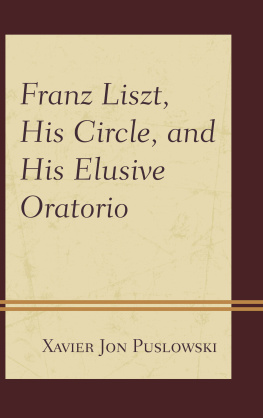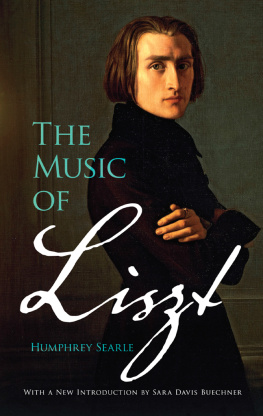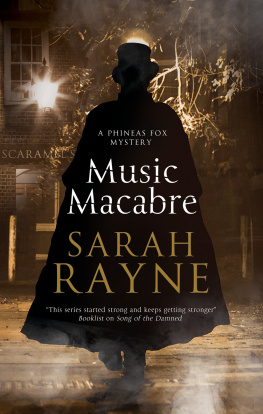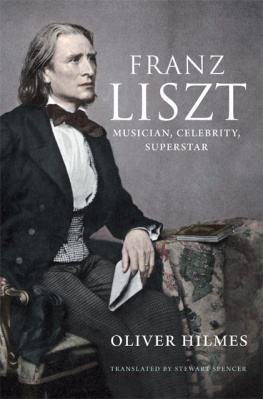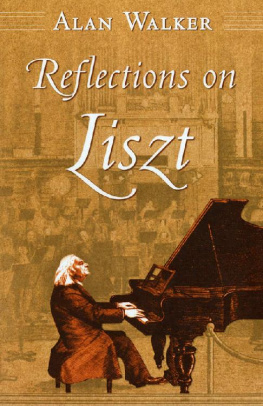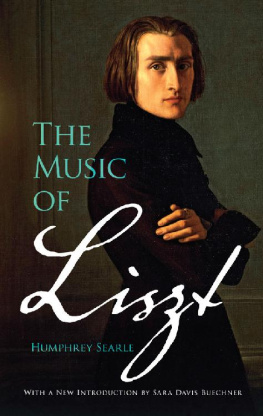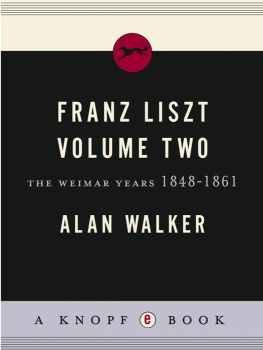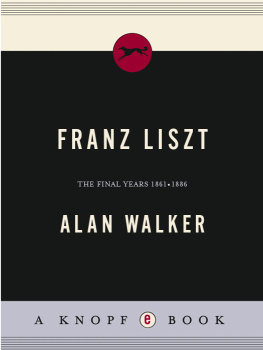1
Introducing Liszt
Liszt in 1,000 Words
Franz Liszt was born on 22 October 1811 at Raiding, today located in Austrias Burgenland. He received his first piano lessons from his father, Adam Liszt, an employee of the celebrated Eszterhzy family. Young Franz was quickly acclaimed a prodigy, and in 1820 a group of Hungarian magnates offered to underwrite his musical education. Shortly thereafter the Liszts moved to Vienna, where Franz studied piano and composition with Carl Czerny and Anton Salieri. Performances there earned Liszt local fame; even Beethoven expressed interest in him.
Seeking additional opportunities for his son, Adam took Franz to Paris, where the boy worked briefly with Ferdinando Par and Anton Reicha. Concert appearances in England and France proved extremely successful, and by 1830 Liszt had published several piano pieces and drafted at least one concerto. In Paris he made the acquaintance of Hector Berlioz, Frdric Chopin, Heinrich Heine, Victor Hugo, and Felicit Lammenais; in 1832 Liszt also heard Paganini perform andso the story goesimmediately resolved to master every aspect of keyboard technique.
Sometime during the early 1830s Liszt fell in love with the Comtesse Marie dAgoult, a married woman who later established a reputation for herself as a historian. In 1835 the couple fled to Switzerland, where for a while Liszt taught at the recently established Geneva Conservatory. For several years the lovers lived comparatively secluded lives, interrupted by travels through the Alps and Italy. By 1838 the young composer had published several important works, including his Apparitions , the first version of his Harmonies potiques et religieuses , fantasies on themes from operas by Auber, Meyerbeer, and Pacini, and transcriptions of pieces by Rossini and Schubert. Immediately thereafter the comtesse gave birth to Liszts children: Blandine, Cosima, and Daniel. Only Cosimawho was married first to Hans von Blow, then to Richard Wagnerwas destined to enter musical history. Blandine died in her twenties after marrying a diplomat; Daniel died in Berlin in 1859.
By 1839 Liszts appearances as a concert artist had grown into a full-time career, and during the 1840s he performed in almost every corner of Europe. Honors were showered upon him: the University of Knigsberg made him a doctor of music, and Budapests citizens presented him with a heros sword. Unfortunately, Liszt and dAgoult quarreled more and more frequently, and they separated in 1844. Meetings with artists such as Schumann and Wagner stimulated Liszts imagination, however, and during these years of transcendental execution he managed to compose dozens of works, including his earliest songs and sacred pieces.
Weimar was only one of many German towns Liszt visited in 1841, but he returned the following year to receive an appointment as Kapellmeister extraordinary to the grand-ducal court. After meeting the Princess Carolyne von Sayn-Wittgenstein during a tour of Ukraine in 1847, he suddenly retired from the concert stage, spent some months in seclusion with her, then settled in Weimar to devote himself to composition and conducting. For more than a decade Liszt lived in a house known as the Altenburg, much of that time with the princess; he gave recitals, taught himself orchestration, conducted performances of his own and others music, and composed almost all his principal works for orchestra as well as dozens of songs and piano pieces, including the B-minor Sonata. Although his productions of Tannhuser and Lohengrin failed to impress Weimars conservative citizens, Liszt became one of Wagners most loyal admirers and apologists; Wagnerat least sometimesone of Liszts closest friends.
Weimar never entirely approved either of Liszts artistic activities or his alliance with Sayn-Wittgenstein, and as the 1850s drew to a close the composer found himself subjected increasingly to criticism from local officials and the musical press. The disastrous reception of Peter Corneliuss Barber of Baghdad prompted Liszt to resign his court appointment in December 1858, and three years later he settled in Rome. The princess planned to join him after Pope Pius IX confirmed her petition for a divorce from her Russian husband, but permission was later withdrawn and no wedding took place. Instead, in 1865, Liszt took minor orders in the Catholic church and began work on his Missa choralis . By the end of the 1860s he had completed Christus as well as a second oratorio on the life of St. Elisabeth of Hungary.
In 1869 Liszt accepted an invitation to return to Weimar and settle in the Hofgrtnerei, a small house on the citys outskirts. He still spent part of each year in Rome, however; and when his appointment as a Royal Hungarian Counselor in 1871 required him to visit Budapest regularly, he began what he later called his vie trifurque (or three-cornered life). During the 1870s and 1880s he gave more of himself to pedagogical activities. Hundreds of pianists flocked to study with himfirst in Germany, then at the Academy of Music he helped establish in Budapest.
Old age brought Liszt increased respect from the Western musical world. His influence over its future also grew: Grieg showed him his famous piano concerto in 1869, Borodin visited him during the early 1870s, and the young Debussy heard him play at a private recital in Rome. Yet Liszts last years were mostly unhappy: his children were dead or estranged from him, his health began to deteriorate, and he fell prey to depression. Wagners unexpected death in 1883 reminded him of his approaching end, and his last works include a series of harmonically progressive piano pieces, several of them written in memory of his former friend. Three years later Liszt undertook a final European summer tour, stopping in England, Belgium, and France before arriving in Bayreuth to visit Cosima and attend a performance in the recently completed Festspielhaus. Already, however, he had become very ill, and on 31 July 1886 he died just before midnight. The Princess Sayn-Wittgenstein, with whom Liszt corresponded almost to the day of his death, survived him by less than a year.
Liszt Studies Past and Present
Three decades ago Alan Walker stated that, Of all the great nineteenth-century composers, Liszt alone still remains to be fully explored (item 41, p. xiii). A flood of books and articles has appeared since Walker wrote those words, but his statement cannot yet be altogether discarded. Liszt remains an enigmatic figure, more written about (and against) than understood. Today, of course, we understand him better than we once did. But much remains to be learned. And interpreted.
The evolution of Liszt studies since the middle of the nineteenth century resembles the evolution of many other humanistic specialties during the same period. Like them, Liszt scholarship has gradually become both more comprehensive and more precise. But Liszt studies has also evolved in its own way. A plethora of nineteenth-century publications had the effect of bringing research almost to a halt during the fifty years separating 1886 (the year of Liszts death) and the 1930s. The so-called Liszt legendthe assumption that Liszt was a kind of musical saintalso stayed the hands of debunking biographers during most of those years, then drove some of them to attack their subject with more enthusiasm than common sense. Only since the mid-1970s has Liszt studies won recognition throughout Europe and the United States as a field for reputable musicological investigators. And only during the past decade has a postmodern Liszt begun to emerge from the workshops of younger and, often, more innovative Liszt specialists.


